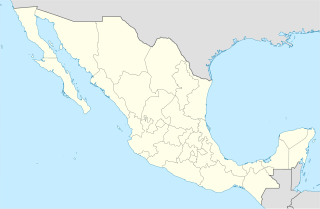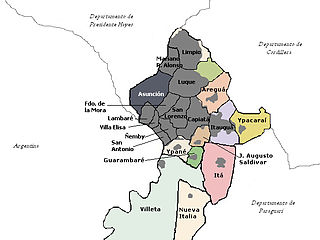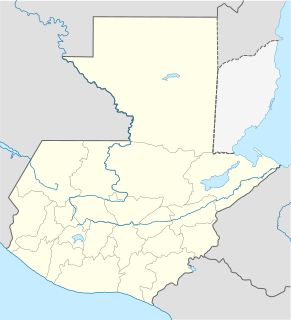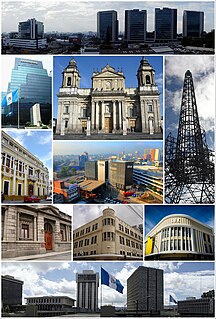This page is based on this
Wikipedia article Text is available under the
CC BY-SA 4.0 license; additional terms may apply.
Images, videos and audio are available under their respective licenses.
Santiago is the Galician evolution of Vulgar Latin Sanctu Iacobu, "Saint James".
San Pedro is the Spanish language form of Saint Peter. It can refer to:
(San) Isidro or (San) Ysidro may refer to:
Santa Elena may refer to:

Asuncion, officially the Municipality of Asuncion, is a 1st class municipality in the province of Davao del Norte, Philippines. According to the 2015 census, it has a population of 59,322 people.
San Antonio is the seventh-most populous city in the United States and the second-most populous in the state of Texas.
Santo Domingo is the capital of the Dominican Republic.

Clethra is a genus of flowering shrubs or small trees described as a genus by Linnaeus in 1753.
La Prensa is a frequently used name for newspapers in the Spanish-speaking world
Vargas is a Spanish and Portuguese surname.
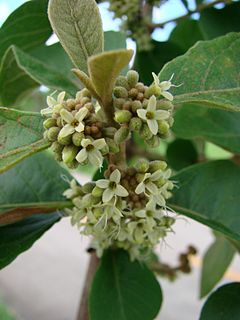
Aegiphila is a genus of flowering plants in the mint family, Lamiaceae, first described in 1763. It was formerly classified in the Verbenaceae. It is native to Mexico, Central America, South America, the West Indies, and Florida.

Gonolobus is a genus of plant in family Apocynaceae, first described in 1803. It is native to South America, Central America, Mexico, the West Indies, and the southern United States.

Citharexylum is a genus of flowering plants in the verbena family, Verbenaceae. It contains shrub and tree species commonly known as fiddlewoods or zitherwoods. They are native to the Americas, ranging from southern Florida and Texas in the United States to Argentina. The highest diversity occurs in Mexico and the Andes. The generic name is derived from the Greek words κιθάρα (kithara), meaning "lyre", and ξύλον (xylon), meaning "wood," referring to the use of the wood in the sounding boards of string instruments. Several species, especially C. caudatum and C. spinosum, are cultivated as ornamentals.
- Citharexylum affine D.Don - from northern Mexico to Nicaragua
- Citharexylum alainii Moldenke - Dominican Republic
- Citharexylum albicaule Turcz. - Cuba
- Citharexylum altamiranum Greenm. - northeastern Mexico
- Citharexylum andinum Moldenke - Bolivia, Jujuy Province of Argentina
- Citharexylum argutedentatum Moldenke - Peru
- Citharexylum berlandieri B.L. Rob. - from Texas to Oaxaca - Berlandier's fiddlewood, Tamaulipan fiddlewood
- Citharexylum bourgeauanum Greenm. - Veracruz, Oaxaca
- Citharexylum brachyanthum (A.Gray ex Hemsl.) A.Gray - Texas, Coahuila, Nuevo León - Boxthorn fiddlewood, Mexican fiddlewood
- Citharexylum bullatum Moldenke - Colombia
- Citharexylum calvum Moldenke - Quintana Roo
- Citharexylum caudatum L. - southern Mexico, West Indies, Central America, Colombia, Peru - Juniper berry
- Citharexylum chartaceum Moldenke - Peru, Ecuador
- Citharexylum cooperi Standl. - Costa Rica, Panama, Guatemala
- Citharexylum costaricense Moldenke - Costa Rica, Nicaragua, Honduras
- Citharexylum crassifolium Greenm - Chiapas, Belize, Guatemala, Honduras
- Citharexylum danirae León de la Luz & F.Chiang - Revillagigedo Islands of Baja California
- Citharexylum decorum Moldenke - Colombia, Venezuela
- Citharexylum dentatum D.Don - Peru
- Citharexylum discolor Turcz. - Cuba, Hispaniola
- Citharexylum donnell-smithii Greenm. - Oaxaca, Chiapas, Central America
- Citharexylum dryanderae Moldenke - Colombia, Venezuela, Peru, Ecuador
- Citharexylum ekmanii Moldenke - Cuba
- Citharexylum ellipticum Moc. & Sessé ex D.Don - Veracruz, Campeche, Tabasco; naturalized in Cuba + Cayman Islands
- Citharexylum endlichii Moldenke - northeastern Mexico
- Citharexylum flabellifolium S.Watson - Sonora, Baja California
- Citharexylum flexuosum (Ruiz & Pav.) D.Don - Bolivia, Peru
- Citharexylum fulgidum Moldenke - Veracruz, northeastern Mexico
- Citharexylum gentryi Moldenke - Ecuador
- Citharexylum glabrum (S.Watson) Greenm - Oaxaca
- Citharexylum glaziovii Moldenke - eastern Brazil
- Citharexylum grandiflorum Aymard & Rueda - Ecuador
- Citharexylum guatemalense (Moldenke) D.N.Gibson - Guatemala, Nicaragua
- Citharexylum herrerae Mansf. - Peru
- Citharexylum hexangulare Greenm. - from northern Mexico to Costa Rica
- Citharexylum hidalgense Moldenke - Mexico
- Citharexylum hintonii Moldenke - México State
- Citharexylum hirtellum Standl. - from Veracruz to Panama
- Citharexylum ilicifolium Kunth - Bolivia, Peru, Ecuador
- Citharexylum iltisii Moldenke - Peru
- Citharexylum × jamaicense Moldenke - Jamaica, Haiti, Puerto Rico (C. caudatum × C. spinosum)
- Citharexylum joergensenii (Lillo) Moldenke - Argentina, Bolivia
- Citharexylum karstenii Moldenke - Colombia, Venezuela
- Citharexylum kerberi Greenm. - Veracruz
- Citharexylum kobuskianum Moldenke - Peru
- Citharexylum krukovii Moldenke - eastern Brazil
- Citharexylum kunthianum Moldenke - Colombia, Venezuela, Ecuador
- Citharexylum laetum Hiern - southern Brazil
- Citharexylum laurifolium Hayek - Bolivia, Peru
- Citharexylum lemsii Moldenke - Guanacaste Province in Costa Rica
- Citharexylum × leonis Moldenke - Cuba (C. caudatum × C. tristachyum)
- Citharexylum ligustrifolium (Thur. ex Decne.) Van Houtte - Mexico
- Citharexylum lojense Moldenke - Ecuador
- Citharexylum lucidum Cham. & Schltdl. - Mexico
- Citharexylum lycioides D.Don - Mexico
- Citharexylum macradenium Greenm. - Panama, Costa Rica
- Citharexylum macrochlamys Pittier - Panama, Colombia
- Citharexylum macrophyllum Poir. - Colombia, Venezuela, Ecuador, Guianas, northwestern Brazil
- Citharexylum matheanum Borhidi & Kereszty - Cuba
- Citharexylum matudae Moldenke - Chiapas
- Citharexylum mexicanum Moldenke - Veracruz, Puebla, Oaxaca
- Citharexylum microphyllum (DC.) O.E.Schulz - Hisipaniola
- Citharexylum mirifolium Moldenke - Colombia, Venezuela
- Citharexylum mocinoi D.Don - Mexico, Central America
- Citharexylum montanum Moldenke - Colombia, Ecuador
- Citharexylum montevidense (Spreng.) Moldenke - Brazil, Argentina, Paraguay, Uruguay
- Citharexylum myrianthum Cham. - Brazil, Argentina, Paraguay
- Citharexylum obtusifolium Kuhlm - Espírito Santo
- Citharexylum oleinum Moldenke - Mexico
- Citharexylum ovatifolium Greenm. - Mexico
- Citharexylum pachyphyllum Moldenke - Peru
- Citharexylum pernambucense Moldenke - eastern Brazil
- Citharexylum poeppigii Walp. - Colombia, Venezuela, Ecuador, Bolivia, Peru, Brazil
- Citharexylum punctatum Greenm. - Bolivia, Peru
- Citharexylum quercifolium Hayek - Peru
- Citharexylum quitense Spreng. - Ecuador
- Citharexylum racemosum Sessé & Moc. - Mexico
- Citharexylum reticulatum Kunth - Ecuador, Peru
- Citharexylum rigidum (Briq.) Moldenke - Paraguay, southern Brazil
- Citharexylum rimbachii Moldenke - Ecuador
- Citharexylum rosei Greenm. - Mexico
- Citharexylum roxanae Moldenke - Baja California
- Citharexylum scabrum Moc. & Sessé ex D.Don - northern Mexico
- Citharexylum schottii Greenm. - southern Mexico, Central America
- Citharexylum schulzii Urb. & Ekman - Hispaniola
- Citharexylum sessaei D.Don - Mexico
- Citharexylum shrevei Moldenke - Sonora
- Citharexylum solanaceum Cham. - southern Brazil
- Citharexylum spinosum L. – Spiny fiddlewood - West Indies, Panama, Venezuela, the Guianas; naturalized in India, Mozambique, Fiji, Bermuda
- Citharexylum stenophyllum Urb. & Ekman - Haiti
- Citharexylum steyermarkii Moldenke - Veracruz, Chiapas, Guatemala
- Citharexylum suberosum Loes. ex Moldenke - Cuba
- Citharexylum subflavescens S.F.Blake - Colombia, Venezuela, Ecuador, Peru
- Citharexylum subthyrsoideum Pittier - Colombia, Venezuela
- Citharexylum subtruncatum Moldenke - northwestern Brazil
- Citharexylum sulcatum Moldenke - Colombia
- Citharexylum svensonii Moldenke - Ecuador
- Citharexylum teclense Standl. - El Salvador
- Citharexylum ternatum Moldenke - Cuba
- Citharexylum tetramerum Brandegee - Valle de Tehuacán-Cuicatlán in Mexico
- Citharexylum tristachyum Turcz. – Threespike Fiddlewood - Cuba, Jamaica, Leeward Islands
- Citharexylum ulei Moldenke - Colombia, Peru, northwestern Brazil
- Citharexylum vallense Moldenke - Colombia
- Citharexylum venezuelense Moldenke - Venezuela
- Citharexylum weberbaueri Hayek - Peru

Smallanthus is a genus of flowering plants in the tribe Millerieae within the sunflower family, Asteraceae.

Sarcoglottis is a genus of flowering plants from the orchid family, Orchidaceae. It is widespread across much of Latin America from Mexico to Argentina, with one species extending northward into Trinidad and the Windward Islands.
San José or San Jose most often refers to:

The Union of Ibero-American Capital Cities, UCCI, is an international, non-governmental organization of 29 major Ibero-American cities that fosters ties and friendly relations between its members. Founded in October 1982, the union is headquartered in Madrid.

